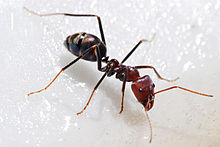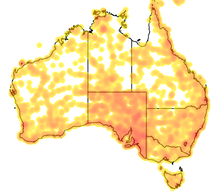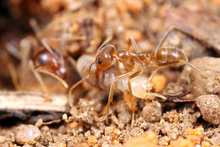虹琉璃蟻屬
| 虹琉璃蟻屬 化石时期:
| |
|---|---|

| |
| 肉蟻(I. purpureus) | |
| 科学分类 | |
| 界: | 动物界 Animalia |
| 门: | 节肢动物门 Arthropoda |
| 纲: | 昆虫纲 Insecta |
| 目: | 膜翅目 Hymenoptera |
| 科: | 蟻科 Formicidae |
| 亚科: | 琉璃蟻亞科 Dolichoderinae |
| 族: | 細臭蟻族 Leptomyrmecini |
| 属: | 虹琉璃蟻屬 Iridomyrmex Mayr, 1862[1] |
| 模式種 | |
| 肉蟻 Formica detecta Smith, 1858
| |
| 物種 | |
|
查看內文 | |
| 多样性[2] | |
| 現生約79種 已滅絕5種 | |
虹琉璃蟻屬(Iridomyrmex),俗名彩虹蟻(rainbow ant, 因其帶有藍綠色彩虹光澤),隸屬於蟻科琉璃蟻亞科,由澳洲昆蟲學家古斯塔夫·邁爾 (Gustav Mayr) 於1862年首次描述,現生有79種,已滅絕有5種,大部分物種原生於澳洲,其餘的原生於亞洲及大洋洲,它們也被人為引入巴西、紐西蘭及阿拉伯地區。已滅絕的物種分布於中國、法國及美國。
它們是優勢種,它們會擾亂土壤組成或進入屋中,所以有時候被當成害蟲。澳洲的農夫會利用肉蟻(I. purpureus)來清除動物屍體,將屍體放在蟻丘上,數週內就會只剩下骨頭。肉蟻會進行儀式性(ritualised)的打鬥,以解決不同群體間的領地衝突,這種方式可以減少傷亡。本屬最大的物種是 I. purpureus 物種複合群(species group),體長約8毫米。
蟻后在婚飛後會建立新的群體,可以是單獨進行,或是透過分巢,也就是一些母群體的工蟻偕同蟻后一起遷徙到新的地點,有時候數隻蟻后會合作築巢,但在工蟻羽化後便會互相攻擊,最後只會剩下一隻蟻后。卵羽化成工蟻需花費44到61天。虹琉璃蟻習性及棲地多樣,因物種而異,有些物種築巢於土壤中,群體大小從數百個體到超過三十萬個體,巢體樣式可以是被卵石覆蓋,有好幾個出入口的大型蟻丘,有些物種在枝條中築巢,有些物種則會建立數個蟻巢,並以通道相連,蟻巢群的長度甚至可以達到650公尺;有些物種會和其他生物共生,像是會提供螞蟻分泌物或蜜露的鱗翅目幼蟲;I. bicknelli 會替蘭花授粉;虹琉璃蟻是掠食者也是清除者,會捕食獵物餵養幼蟲;虹琉璃蟻免疫海蟾蜍的毒素,能夠獵食未成熟的海蟾蜍;虹琉璃蟻的獵食者有蜘蛛、鳥類、蜥蜴或其他螞蟻。
系統發生學[编辑]
虹琉璃蟻屬與最近的祖先約在1200萬年前分化[3],雖然虹琉璃蟻屬與其姊妹群 Froggattella 屬所歷經的時間相同[4],但 Froggattella 屬只有2個物種,相較於其他印澳地區的屬,該支系較為年輕,琉璃蟻亞科約在2300萬年前分化,虹琉璃蟻屬的化石分布於使新世及寡新世[5]。以下為虹琉璃蟻屬在印澳地區琉璃蟻亞科的屬的系統發生地位[3]。
| Indo‑Australian genera |
| |||||||||||||||||||||||||||||||||||||||||||||||||||
分類學[编辑]
虹琉璃蟻屬由澳洲昆蟲學家 Gustav Mayr 於1862年首次描述[6],但直到1903年才指定模式種[4],模式種為 Formica detecta,Iridomyrmex purpureus 的同物異名[7][8],1878年琉璃蟻亞科建立之後虹琉璃蟻屬被分類到其下[9],虹琉璃蟻屬的分類早期錯綜複雜,因為早期的研究者沒有辨認出虹琉璃蟻屬的關鍵特徵,因此把很多物種錯置於虹琉璃蟻屬下[4][10]。
螞蟻學家 William Brown 二世是第一個質疑虹琉璃蟻屬並非單系群的人[4],他指出阿根廷蟻(舊時隸屬虹琉璃蟻屬)和其他虹琉璃蟻屬物種的相異之處[11]。虹琉璃蟻屬首次重整是在1990年代,其下的91個物種被重新分配到了6個屬,分別是Anonychomyrma 屬、Doleromyrma 屬、Linepithema 屬、Ochetellus 屬、Papyrius 屬和 Philidris 屬 ,重整後只有62個物種仍隸屬虹琉璃蟻屬[4],2011年,虹琉璃蟻屬再次重整,第二次重整後,虹琉璃蟻屬現在包含79個現生物種及5個已滅絕物種,其中有31個是新發表的物種[4],4個物種被分配到其他屬之下,25個物種及亞種被歸類為同物異名。根據單篇資料來源指出,澳洲虹琉璃蟻屬的物種可能有350種[12]。
虹琉璃蟻屬的學名:Iridomyrmex ,意思是彩虹般的螞蟻,因其藍綠色的彩虹光澤而得名[13],Irido 為古希臘文,意思是彩虹[14];myrmex ,也是古希臘文,意思是螞蟻[15]。
物種[编辑]
(已滅絕物種以 † 標示)
- Iridomyrmex adstringatus Heterick & Shattuck, 2011
- Iridomyrmex agilis Forel, 1907
- Iridomyrmex alpinus Heterick & Shattuck, 2011
- Iridomyrmex anceps (Roger, 1863)
- Iridomyrmex anderseni Shattuck, 1993
- Iridomyrmex angusticeps Forel, 1901
- Iridomyrmex anteroinclinus Shattuck, 1993
- Iridomyrmex atypicus Heterick & Shattuck, 2011
- Iridomyrmex azureus Viehmeyer, 1914
- Iridomyrmex bicknelli Emery, 1898
- Iridomyrmex bigi Shattuck, 1993
- Iridomyrmex brennani Heterick & Shattuck, 2011
- †Iridomyrmex breviantennis Théobald, 1937
- Iridomyrmex brunneus Forel, 1902
- Iridomyrmex calvus Emery, 1914
- Iridomyrmex cappoinclinus Shattuck, 1993
- Iridomyrmex cephaloinclinus Shattuck, 1993
- Iridomyrmex chasei Forel, 1902
- Iridomyrmex coeruleus Heterick & Shattuck, 2011
- Iridomyrmex conifer Forel, 1902
- Iridomyrmex continentis Forel, 1907
- Iridomyrmex cuneiceps Heterick & Shattuck, 2011
- Iridomyrmex cupreus Heterick & Shattuck, 2011
- Iridomyrmex curvifrons Heterick & Shattuck, 2011
- Iridomyrmex cyaneus Wheeler, 1915
- Iridomyrmex difficilis Heterick & Shattuck, 2011
- Iridomyrmex discors Forel, 1902
- Iridomyrmex dromus Clark, 1938
- Iridomyrmex elongatus Heterick & Shattuck, 2011
- Iridomyrmex exsanguis Forel, 1907
- †Iridomyrmex florissantius Carpenter, 1930
- Iridomyrmex fulgens Heterick & Shattuck, 2011
- Iridomyrmex galbanus Shattuck, 1993
- Iridomyrmex gibbus Heterick & Shattuck, 2011
- Iridomyrmex gumnos Heterick & Shattuck, 2011
- Iridomyrmex hartmeyeri Forel, 1907
- Iridomyrmex hertogi Heterick & Shattuck, 2011
- Iridomyrmex hesperus Shattuck, 1993
- Iridomyrmex infuscus Heterick & Shattuck, 2011
- Iridomyrmex innocens Forel, 1907
- Iridomyrmex lividus Shattuck, 1993
- Iridomyrmex longisoma Heterick & Shattuck, 2011
- Iridomyrmex luteoclypeatus Heterick & Shattuck, 2011
- Iridomyrmex macrops Heterick & Shattuck, 2011
- †Iridomyrmex mapesi Wilson, 1985
- Iridomyrmex mattiroloi Emery, 1898
- Iridomyrmex mayri Forel, 1915
- Iridomyrmex meridianus Heterick & Shattuck, 2011
- Iridomyrmex minor Forel, 1915
- Iridomyrmex mirabilis Heterick & Shattuck, 2011
- Iridomyrmex mjobergi Forel, 1915
- Iridomyrmex neocaledonica Heterick & Shattuck, 2011
- Iridomyrmex niger Heterick & Shattuck, 2011
- Iridomyrmex nudipes Heterick & Shattuck, 2011
- †Iridomyrmex obscurans Carpenter, 1930
- Iridomyrmex obscurior Forel, 1902
- Iridomyrmex obsidianus Emery, 1914
- Iridomyrmex omalonotus Heterick & Shattuck, 2011
- Iridomyrmex pallidus Forel, 1901
- Iridomyrmex phillipensis Heterick & Shattuck, 2011
- Iridomyrmex prismatis Shattuck, 1993
- Iridomyrmex purpureus (Smith, 1858)
- Iridomyrmex reburrus Shattuck, 1993
- Iridomyrmex roseatus Heterick & Shattuck, 2011
- Iridomyrmex rubriceps Forel, 1902
- Iridomyrmex rufoinclinus Shattuck, 1993
- Iridomyrmex rufoniger (Lowne, 1865)
- Iridomyrmex sanguineus Forel, 1910
- Iridomyrmex setoconus Shattuck & McMillan, 1998
- †Iridomyrmex shandongicus Zhang, 1989
- Iridomyrmex spadius Shattuck, 1993
- Iridomyrmex splendens Forel, 1907
- Iridomyrmex spodipilus Shattuck, 1993
- Iridomyrmex spurcus Wheeler, 1915
- Iridomyrmex suchieri Forel, 1907
- Iridomyrmex suchieroides Heterick & Shattuck, 2011
- Iridomyrmex tenebrans Heterick & Shattuck, 2011
- Iridomyrmex tenuiceps Heterick & Shattuck, 2011
- Iridomyrmex trigonoceps Heterick & Shattuck, 2011
- Iridomyrmex turbineus Shattuck & McMillan, 1998
- Iridomyrmex victorianus Forel, 1902
- Iridomyrmex viridiaeneus Viehmeyer, 1914
- Iridomyrmex viridigaster Clark, 1941
- Iridomyrmex xanthocoxa Heterick & Shattuck, 2011
描述[编辑]
虹琉璃蟻屬不同於其他琉璃蟻亞科的物種,虹琉璃蟻屬的頭楯前緣高於大顎;眼睛位於頭部的最上方,遠離大顎[4][16],虹琉璃蟻屬為中小型物種:I. conifer 物種複合群的物種體長約為4毫米,體色紅棕色,前伸腹板明顯突出;I. purpureus 物種複合群的物種體型最大,體長約為8毫米[17]。
虹琉璃蟻屬物種的工蟻罕有多形性[4]。
觀察結果顯示,畸形的工蟻存在於自然環境中,例如以下案例,有隻工蟻的前伸腹節與腹垂節癒合,雖然腹柄節存在,但卻異常增大,儘管畸形導致一點阻礙,該工蟻仍有活動能力[18]。
分布地區及棲地[编辑]

虹琉璃蟻屬的物種分布在許多國家和島嶼,範圍橫跨好幾個大陸,在大洋洲地區分布於斐濟、印尼、新多里喀尼亞、巴布亞新幾內亞和所羅門群島[4][19][20];澳洲的每個州都有分布[21];紐西蘭則是被人為引入,分布於北島及南島[22];在亞洲則分布於緬甸、東帝汶、印度、馬來西亞和菲律賓[4][23]。唯一分布於中東地區的物種是 I. anceps ,被人為引入阿拉伯聯合大公國;I. rufoniger 被人為引入巴西[4][24];大洋洲的諾福克島和菲律普島也有族群[4]。已滅絕物種的分布範圍大於現生的分布範圍,中國、法國和美國都曾出土過虹琉璃蟻的化石[25][26][27]。

虹琉璃蟻棲息在市郊,乾燥和半乾燥地區, 棲息於相思樹、貝殼杉、班庫樹、木麻黃、桉樹等林地中,也棲息於牧場、澳洲柏森林、都市公園、農地、草原、石楠樹林地、沙丘、稀樹草原、沼澤、都市花園、潮濕雨林、硬葉林,或是人造建物。
虹琉璃蟻大部分會在土壤中築巢,但有些也會住在石頭下、朽木中,甚至是沙灘、人行道中[4],某些物種會避免在沙質土壤中築巢[28],巢體外觀多變,大部分是具有單個出入口的小型蟻丘,有些物種的巢體則是被卵石覆蓋且具有多個出入口的大型蟻丘[4],某些物種會築出超級巢體,數個巢體彼此透過通道相連,長度可達650公尺[16],曾經有個案例,有個群體佔據了超過10公頃的地,總共有85個巢體和1500個出入口[29]。肉蟻不會攻擊巢友,但是會攻擊居住在不同巢體但同一群體的個體[30]。巢體可以是高於地表或低於地表,有些物種如 I. conifer 高於或低於地表的巢都有,冬天時它們會築巢於樹枝上,天氣回暖時棲息在地下[16],地下巢築在食物充足的地區,冬天時群體會移居到陽光充足的地方[31]。
行為和生態學[编辑]

大部分的虹琉璃蟻習性兇悍,會主動攻擊騷擾巢穴或是覓食時遇到的生物,特別是 I. purpureus 物種複合群的物種,它們會湧出巢穴殺死入侵者[4];小型的物種也很兇悍,它們會噴灑虹琉璃蟻素(iridomyrmecin),一種虹琉璃蟻屬專有的防禦物質[4],虹琉璃蟻數量大,生性兇悍,活動力強,在澳洲是優勢種,某些物種會佔據資源,阻止其他昆蟲前來取食[32],它們數量多又活躍,甚至能影響其他螞蟻的覓食行為[4]。
雖然虹琉璃蟻以兇悍著名,有些物種生性膽小,遭到騷擾只會逃離或躲藏,也會避免和其他螞蟻接觸[4];如果巢穴受到攻擊,它們不會反擊,而是把幼蟲搬走,然後什麼也不做,它們會躲在落葉裡或植物裡,有些物種如 I. victorianus 遭受威脅時會靜止不動[4]。
當鄰近的肉蟻群體發生領地衝突時,它們會透過儀式性的打鬥來解決紛爭[33][34],不同群體的個體相遇時,它們會快速地揮動觸角,張開大顎,盡可能的張開身體讓自己看起來更高更大,這行為暗示著肉蟻的打鬥是透過比較體型進行[34],打鬥結束後,它們會清潔自己的身體,繼續尋找下一隻螞蟻[33],有些群體間的衝突可以持續數月甚至數年,但是真正會導致嚴重傷亡的打鬥極為罕見。
覓食[编辑]
虹琉璃蟻是獵食者和清除者,它們也會和半翅目及鱗翅目幼蟲互動以取得蜜露[4],它們會獵食小型昆蟲,取食花粉[4],它們通常在地面上覓食,但大多數物種還會爬到植株上覓食;虹琉璃蟻大多數活動於晝夜,但有些是夜行性[4],它們白天時會堵住出入口,如果天氣合適,有些夜行性的物種也會在白天活動,但是有些物種,如 I. bigi 無論如何都不會在白天活動;有些物種會築巢在沒有陰影的地方,日出之後他們就可以曬太陽暖活身子,然後開始覓食[35]。
食性[编辑]

虹琉璃蟻主要取食甜食,如花粉及蜜露[4],工蟻會獵食昆蟲或其他螞蟻來餵食幼蟲[16],工蟻會被長有油質體的種子吸引,它們會收集種子,剝下油質體後丟棄種子,這些留在螞蟻附近的種子擁有較高的存活率[5]。
它們有時候會在白蟻丘裡築巢[36],如此它們就可以就近捕食白蟻,除了捕食以外,目前沒有任何證據顯示白蟻和螞蟻有任何交互作用[4],有些免疫海蟾蜍毒素的物種會捕食未成年的海蟾蜍[37],如 I. purpureus 和 I. ruburrus[38][39],由於此特性,有人提議在海蟾蜍棲地釋放虹琉璃蟻巢,以達到生物防治的目的。
肉蟻是澳洲唯一會取食海鳥糞的螞蟻[40]。
獵食者[编辑]
有些無脊椎動物專食虹琉璃蟻: 遊走蛛(Habronestes bradleyi) 會追蹤它們的緊戒費洛蒙[41][42][43][44];澳洲多刺魔蜥(Moloch horridus)是伏擊型的獵食者,專食虹琉璃蟻屬的物種,它們甚至會專食特定單一物種,拒食同屬其他物種[45];盲蛇 Ramphotyphlops nigrescens 會追蹤它們的行經的路徑,取食部分物種的幼蟲和卵[46];有些地甲蟲會躲在蟻巢附近的土中,捕食經過的工蟻[47]。
短吻針鼴(Tachyglossus aculeatus)會在婚飛期間捕食高脂肪含量的處女蟻后[48],它們也會在八月到十月攻擊蟻巢,捕食巢中的繁殖型個體[49],蟻后在婚飛期後仍然處於危險之中,因為有些鳥,如澳洲喜鵲、渡鴉,會被剛翻過的土壤吸引,它們會翻開土壤捕食那些剛建立新群體的蟻后[50];寄生性的絛蟲也會感染虹琉璃蟻[51]。
生命週期與繁殖[编辑]

在溫帶潮濕氣候區,它們全年都會婚飛[4],婚飛進行時,繁殖蟻會離開巢穴爬到高處,準備起飛和交配[4],蟻后會和單隻或多隻雄蟻交配,因物種而異[52];根據觀察結果,肉蟻是雄蟻先起飛再來才是蟻后[50];20至40隻蟻后會聚集到巢穴的頂端,並在身體暖活後起飛,這個週期一天內會持續數次,並且維持數天,直到氣候改變或是巢中沒有任何蟻后[50],雄蟻在交配之後就會死去,蟻后則會尋找適合的地方建立群體,尋找的過程中它們會暴露在鳥類或其他獵食者的威脅之中[53],也會因為各種原因,如疾病或飢餓導致死亡[50];大多數的蟻后獨自築巢,但也可以是多個蟻后合作築巢、被其他群體納入巢中,或是「分巢」,也就是母群體的一部分離開舊巢建立新巢[54]。10%的蟻后會和其他蟻后合作築巢[55]。

蟻后掘出巢室後會產下大約20顆卵,它們會在一個月內孵化,卵羽化成成蟲需花費44到61天[54][56];成熟巢穴個體數各異,從數百到30萬以上不等[5][57],大多數的群體是單后型,但也有多達四隻蟻后的群體[50][58],寡后型(Oligogynous)的群體也存在,巢中存在多個蟻后,蟻后間彼此爭奪產權,但不同蟻后產下的工蟻不會攻擊不同的蟻后[54][59],蟻后只會照顧自己的卵幼[58][60],群體成長到一定規模後,蟻后就不會繼續聚集[54][61]。
共生生物[编辑]

虹琉璃蟻會和鱗翅目幼蟲、蚜蟲及介殼蟲共生[16][62][63],工蟻會保護鱗翅目幼蟲,有時候還會把它們搬入巢中[16]。會和虹琉璃蟻共生的鱗翅目包含佳灰蝶(Jalmenus clementi、Jalmenus daemeli、Jalmenus eichhorni、Jalmenus evagoras、Jalmenus icilius、Jalmenus inous、Jalmenus lithochroa)[64]:246–248 [65]、澳灰蝶(Ogyris amaryllis、Ogyris olane、Ogyris oroetes)[64]:234–236、灰尖角灰蝶(Anthene lycaenoides)[64]:270、希特坎灰蝶(Candalides heathi)[64]:266、Candalides margarita (trident pencil-blue), Deudorix diovis (bright cornelian),[64]:256–258 Euchrysops cnejus (gram blue),[64]:290 Lampides boeticus (pea blue),[64]:290 Leptotes plinius (plumbago blue),[64]:288 Lucia limbaria (chequered copper),[64]:214 Nesolycaena caesia (Kimberly spotted opal),[64]:214 Neolucia agricola (fringed heath-blue)[64]:280 and Theclinesthes serpentata (saltbush blue).[64]:288 。I. bicknelli 會替 Microtis parviflora 授粉[66],且研究指出螞蟻不會傷害花粉[67]。
肉蟻會在清晨時用卵石和沙土堵住 Camponotus consobrinus 的巢穴出入口,阻擋它們離開巢穴,遭到這種對待的螞蟻也會回擊,用植物纖維堵住肉蟻的巢穴出入口[68][69];如果肉蟻的巢穴被樹木或其他陰影蓋住,由於照曬不到陽光,群體的健康狀況會惡化[70],Camponotus consobrinus 就會入侵肉蟻的巢穴,用一種黑色的樹脂類物質堵住通道,受攻擊的肉蟻群體會搬到其他的地方[71]。
與人類的互動[编辑]
在澳洲郊外,肉蟻是農夫不可或缺的幫手,農夫會把動物屍體放到肉蟻巢上,數周內,屍體會被吃到剩骨頭[72];虹琉璃蟻有時候也是害蟲,它們會進到屋中,取食人類的食物[73],還會翻動土壤擾亂土質[74],清除蟻巢很困難,因為如果沒有徹底清除,來自鄰近群體的個體會補充待清除蟻巢的個體數[75];有些物種在都市地區適應良好;在坎培拉早期,人為活動影響環境,改變後的植被與花園提供了食物來源[76],於是肉蟻數量快速成長。肉蟻會造成阻礙生物防治半翅目昆蟲,特別是那些會分泌蜜露的,進而造成柑橘種植者的困擾[77]。
延伸閱讀[编辑]
參考文獻[编辑]
- ^ Johnson, Norman F. Iridomyrmex Mayr. Hymenoptera Name Server version 1.5. Columbus, Ohio, USA: Ohio State University. 2007-12-19 [2015-06-11]. (原始内容存档于2015-06-11).
- ^ Bolton, B. Iridomyrmex. AntCat. 2014 [18 August 2014].
- ^ 3.0 3.1 Ward, P.S.; Brady, S.G; Fisher, B.L.; Schultz, T.R. Phylogeny and biogeography of dolichoderine ants: effects of data partitioning and relict taxa on historical inference. Systematic Biology. 2010, 59 (3): 342–362. PMID 20525640. doi:10.1093/sysbio/syq012.
- ^ 4.00 4.01 4.02 4.03 4.04 4.05 4.06 4.07 4.08 4.09 4.10 4.11 4.12 4.13 4.14 4.15 4.16 4.17 4.18 4.19 4.20 4.21 4.22 4.23 4.24 4.25 Shattuck, Steve; Heterick, Brian E. Revision of the ant genus Iridomyrmex (Hymenoptera : Formicidae) (PDF) 2845. 2011: 1–74 [2019-01-29]. ISBN 978-1-86977-676-3. ISSN 1175-5334. (原始内容存档 (PDF)于2021-03-15).
|journal=被忽略 (帮助) - ^ 5.0 5.1 5.2 Shattuck, Steve; Barnett, Natalie. Iridomyrmex Mayr, 1862. Ants Down Under. CSIRO. June 2010 [2015-05-23]. (原始内容存档于2010-06-06).
- ^ Mayr, Gustav. Myrmecologische Studien (PDF). Verhandlungen der Zoologisch-Botanischen Gesellschaft in Wien. 1862, 12: 649–776 [2019-01-29]. (原始内容存档 (PDF)于2016-03-03).
- ^ Bingham, C.T. The fauna of British India, including Ceylon and Burma. Hymenoptera, Vol. II. Ants and Cuckoo-wasps (PDF). London: Taylor and Francis. 1903: 297.
- ^ Lowne, B.T. Contributions to the natural history of Australian ants. Entomologist. 1865, 2: 273–280.
- ^ Forel, Auguste H. Études myrmécologiques en 1878 (première partie) avec l'anatomie du gésier des fourmis. Bulletin de la Société Vaudoise des Sciences Naturelles. 1878, 15: 337–392.
- ^ Shattuck, Steve O. Generic revision of the ant subfamily Dolichoderinae (Hymenoptera: Formicidae) (PDF). Sociobiology. 1992, 21 (1): 1–181. ISSN 0361-6525.
- ^ Brown, William, Jr. A review of the ants of New Zealand (PDF). Acta Hymenopterologica. 1958, 1: 1–50 [2019-01-29]. (原始内容存档 (PDF)于2016-03-03).
- ^ Andersen, A.N. Ant diversity in arid Australia: a systematic overview (PDF). Memoirs of the American Entomological Institute. 2007, 80: 19–51 [2019-01-29]. (原始内容存档 (PDF)于2015-04-17).
- ^ AntWeb. Genus: Iridomyrmex. The California Academy of Sciences. [2015-04-12]. (原始内容存档于2021-02-26).
- ^ Rosenthal, Gerald A.; Berenbaum, May R. Herbivores: Their Interactions with Secondary Plant Metabolites: The Chemical Participants 2nd. Academic Press. 2012: 299. ISBN 978-0-323-13940-3.
- ^ Harper, Douglas. Formica. Online Etymology Dictionary.
- ^ 16.0 16.1 16.2 16.3 16.4 16.5 Genus Iridomyrmex. Australian Ants. CSIRO. 2001 [2015-02-03]. (原始内容存档于2008-02-09).
- ^ Andersen, Alan N. The ants of southern Australia: a guide to the Bassian fauna. East Melbourne, Australia: CSIRO Publishing. 1991: 40. ISBN 978-0-643-05152-2.
- ^ Majer, J.D. Notes on a deformed worker of the ant genus Iridomyrmex (Hymenoptera: Formicidae). Australian Entomological Magazine. 1983, 10 (1): 11–12.
- ^ Emery, Carlo. Lesfourmis de la Nouvelle-caledonie et des iles Loyalty (PDF). Nova Caledonia a Zoologie. 1914, 1: 393–436 [2019-01-29]. OCLC 29171557. (原始内容存档 (PDF)于2016-03-04).
- ^ Forel, Auguste. Formiciden aus dem Bismarck-Archipel, auf Grundlage des von Prof. Dr. F. Dahl gesammelten Materials bearbeitet (PDF). Mitteilungen aus dem Zoologischen Museum in Berlin. 1901, 2: 1–37 [2019-01-29]. ISSN 0373-8493. (原始内容存档 (PDF)于2017-08-15).
- ^ Department of the Environment. Genus Iridomyrmex Mayr, 1862. Australian Biological Resources Study: Australian Faunal Directory. Canberra: Government of Australia. 2015-05-15 [2014-08-18]. (原始内容存档于2015-09-24).
- ^ Don, Warwick. Ants of New Zealand. Dunedin: Otago University Press. 2007: 157–159. ISBN 978-1-877372-47-6.
- ^ Roger, Julius. Die neu aufgeführten Gattungen und Arten meines Formiciden-Verzeichnisses nebst Ergänzung einiger früher gegebenen Beschreibungen. Berliner Entomologische Zeitschrift. 1863, 7 (1–2): 131–214. doi:10.1002/mmnd.18630070116.
- ^ Collingwood, Cedric A.; Tigar, Barbara J.; Agosti, Donat. Introduced ants in the United Arab Emirates. Journal of Arid Environments. November 1997, 37 (3): 505–512. Bibcode:1997JArEn..37..505C. doi:10.1006/jare.1997.0309.
- ^ Zhang, J. Fossil insects from Shanwang, Shandong, China. Jinan, China: Shandong Science and Technology Publishing House. 1989: 278.
- ^ Théobald, Nicolas. Les insectes fossiles des terrains oligocènes de France (PDF) 2. Université de Nancy. 1937: 209 [2019-01-29]. (原始内容存档 (PDF)于2016-03-04) (法语).
- ^ Carpenter, F.M. The fossil ants of North America (PDF). Bulletin of the Museum of Comparative Zoology. 1930, 70: 1–66 [2019-01-29]. (原始内容存档 (PDF)于2016-03-03).
- ^ Greenslade, P. J. M. The identity of Iridomymex purpureus form viridiaeneus Viehmeyer (Hymenoptera: Formicidae). Australian Journal of Entomology. September 1974, 13 (3): 247–248. doi:10.1111/j.1440-6055.1974.tb02181.x.
- ^ Greenslade, P. J. M.; Halliday, R. B. Colony dispersion and relationships of meat ants Iridomyrmex purpureus and allies in an arid locality in south Australia. Insectes Sociaux. March 1983, 30 (1): 82–99. ISSN 1420-9098. doi:10.1007/BF02225659.
- ^ van Wilgenburg, E.; Ryan, D.; Morrison, P.; Marriott, P. J.; Elgar, M. A. Nest- and colony-mate recognition in polydomous colonies of meat ants (Iridomyrmex purpureus). Naturwissenschaften. March 2006, 93 (7): 309–314. Bibcode:2006NW.....93..309V. PMID 16555093. doi:10.1007/s00114-006-0109-y.
- ^ Shattuck, Steven O.; McMillan, Peter. Revision of the species of the Iridomyrmex conifer group (Hymenoptera : Formicidae), with notes on their biology. Australian Journal of Zoology. 1998, 46 (3): 301. doi:10.1071/ZO98033.
- ^ Andersen, A. N.; Patel, A. D. Meat ants as dominant members of Australian ant communities: an experimental test of their influence on the foraging success and forager abundance of other species. Oecologia. June 1994, 98 (1): 15–24. Bibcode:1994Oecol..98...15A. ISSN 1432-1939. PMID 28312791. doi:10.1007/BF00326085.
- ^ 33.0 33.1 Ettershank, G.; Ettershank, J. A. Ritualised fighting in the meat ant Iridomyrmex purpureus (Smith) (Hymenoptera: Formicidae). Australian Journal of Entomology. May 1982, 21 (2): 97–102. doi:10.1111/j.1440-6055.1982.tb01772.x.
- ^ 34.0 34.1 Elgar, Mark A.; Wilgenburg, E. van; Lieshout, Emile van. Conflict resolution strategies in meat ants (Iridomyrmex purpureus): ritualised displays versus lethal fighting. Behaviour. 2005-06-01, 142 (6): 701–716. doi:10.1163/1568539054729150.
- ^ Andrews, E.A. Ant-mounds as to temperature and sunshine. Journal of Morphology. 1927, 44 (1): 1–20. doi:10.1002/jmor.1050440102.
- ^ Wheeler, William Morton. Ecological Relations of Ponerine and Other Ants to Termites. Proceedings of the American Academy of Arts and Sciences. 1936, 71 (3): 159–171. JSTOR 20023221. doi:10.2307/20023221.
- ^ Richard, Shine. The Ecological Impact of Invasive Cane Toads (Bufo Marinus) in Australia (PDF). The Quarterly Review of Biology. 2010, 85 (3): 253–291 [2019-01-29]. JSTOR 655116. doi:10.1086/655116. (原始内容 (PDF)存档于2015-06-11).
- ^ Ward-Fear, Georgia; Brown, Gregory P.; Shine, Richard. Using a native predator (the meat ant, Iridomyrmex reburrus) to reduce the abundance of an invasive species (the cane toad, Bufo marinus) in tropical Australia. Journal of Applied Ecology. April 2010, 47 (2): 273–280. doi:10.1111/j.1365-2664.2010.01773.x.
- ^ Clerke, R. B.; Williamson, I. A note on the predation of Bufo marinus juveniles by the ant Iridomyrmex purpureus. Australian Zoologist. 1992-12-01, 28 (1): 64–67. doi:10.7882/AZ.1992.015.
- ^ Moulds, Timothy. The first Australian record of subterranean guano-collecting ants (PDF). Helictite. 2006, 39 (1): 3–4 [2019-01-29]. (原始内容存档 (PDF)于2021-03-04).
- ^ Herberstein, Marie Elisabeth. Spider Behaviour: Flexibility and Versatility. Cambridge University Press. 2011: 139. ISBN 978-1-139-49478-6.
- ^ Capinera, John L. Encyclopedia of Entomology 4. Springer Science & Business Media. 2008: 93. ISBN 978-1-4020-6242-1.
- ^ Litwack, Gerald. Pheromones 83. Academic Press. 2010: 227. ISBN 978-0-12-381533-0. ISSN 0083-6729.
- ^ Allan, R.A.; Elgar, M.A.; Capon, R.J. Exploitation of an ant chemical alarm signal by the zodariid spider Habronestes bradley Walckenaer. Proceedings of the Royal Society B. 1996, 263 (1366): 69–73. Bibcode:1996RSPSB.263...69A. doi:10.1098/rspb.1996.0012.
- ^ Withers, PC; Dickman, CR. The role of diet in determining water, energy and salt intake in the thorny devil Moloch horridus (Lacertilia: Agamidae) (PDF). Journal of the Royal Society of Western Australia. 1995, 78 (3) [2019-01-29]. (原始内容存档 (PDF)于2021-03-14).
- ^ Webb, Jonathan K.; Shine, Richard. To find an ant: trail-following in Australian blindsnakes (Typhlopidae). Animal Behaviour. 1992, 43 (6): 941–948. doi:10.1016/S0003-3472(06)80007-2.
- ^ Moore, B.P. The larval habits of two species of Sphallomorpha Westwood (Coleoptera: Carabidae: Pseudomorphinae). Australian Journal of Entomology. 1974, 13 (3): 179–183. doi:10.1111/j.1440-6055.1974.tb02171.x.
- ^ Griffiths, M.; Simpson, K.G. A seasonal feeding habit of Spiny Ant-eaters. CSIRO Wildlife Research. 1966, 11 (1): 137–143. doi:10.1071/CWR9660137.
- ^ Griffiths, Mervyn. The Biology of the Monotremes. Elsevier. 2012: 84. ISBN 978-0-323-15331-7.
- ^ 50.0 50.1 50.2 50.3 50.4 Greaves, T.; Hughes, R. D. The Population Biology of the Meat Ant. Australian Journal of Entomology. December 1974, 13 (4): 329–351. doi:10.1111/j.1440-6055.1974.tb02212.x.
- ^ Schmid-Hempel, Paul. Parasites in social insects. New Jersey: Princeton University Press. 1998: 61. ISBN 978-0-691-05924-2.
- ^ Hölldobler & Wilson 1990,第156頁.
- ^ Hölldobler & Wilson 1990,第210頁.
- ^ 54.0 54.1 54.2 54.3 Hölldobler, Bert; Carlin, Norman F. Colony founding, queen dominance and oligogyny in the Australian meat ant Iridomyrmex purpureus. Behavioral Ecology and Sociobiology. 1985, 18 (1): 45–58. ISSN 1432-0762. JSTOR 4599861. doi:10.1007/BF00299237 (不活跃 2018-10-14).
- ^ Hölldobler & Wilson 1990,第217頁.
- ^ Hölldobler & Wilson 1990,第170頁.
- ^ Hölldobler & Wilson 1990,第163頁.
- ^ 58.0 58.1 Trager, James C. Advances in myrmecology 1st. Leiden, Netherlands: E.J. Brill. 1988: 203, 271–272. ISBN 978-0-916846-38-1.
- ^ Michelucci, Pietro. Handbook of Human Computation. New York, NY: Springer New York. 2013: 931. ISBN 978-1-4614-8806-4.
- ^ Hölldobler & Wilson 1990,第202頁.
- ^ Hölldobler & Wilson 1990,第159頁.
- ^ Eastwood, Rod; Fraser, Ann M. Associations between lycaenid butterflies and ants in Australia. Austral Ecology. October 1999, 24 (5): 503–537. doi:10.1046/j.1440-169x.1999.01000.x.
- ^ Fielder, Konrad. Ants that associate with Lycaeninae butterfly larvae: diversity, ecology and biogeography. Diversity and Distributions. 2001, 7 (1–2): 45–60. JSTOR 2673358. doi:10.1046/j.1472-4642.2001.00096.x.
- ^ 64.00 64.01 64.02 64.03 64.04 64.05 64.06 64.07 64.08 64.09 64.10 64.11 Braby, Michael F. The complete field guide to butterflies of Australia. Collingwood, Vic.: CSIRO Publishing. 2004. ISBN 978-0-643-09027-9.
- ^ Kitching, R.; Jones, E.; Jones, R.; Pierce, NE. Biology of Australian Butterflies. Sydney: CSIRO Press. 1999: 277–316.
- ^ Peakall, R.; Beattie, A.J. Pollination of the Orchid Microtis parviflora R. Br. by Flightless Worker Ants. Functional Ecology. 1989, 3 (5): 515–522. JSTOR 2389565. doi:10.2307/2389565.
- ^ Peakall, Rod; Angus, Craig J.; Beattie, Andrew J. The significance of ant and plant traits for ant pollination in Leporella fimbriata. Oecologia. October 1990, 84 (4): 457–460. Bibcode:1990Oecol..84..457P. ISSN 1432-1939. PMID 28312960. doi:10.1007/BF00328160.
- ^ Gordon, Deborah M. Nest-plugging: interference competition in desert ants (Novomessor cockerelli and Pogonomyrmex barbatus). Oecologia. 1988, 75 (1): 114–118. Bibcode:1988Oecol..75..114G. ISSN 1432-1939. PMID 28311843. doi:10.1007/BF00378823.
- ^ Hölldobler & Wilson 1990,第424頁.
- ^ Cowan, J. A.; Humphreys, G. S.; Mitchell, P. B.; Murphy, C. L. An assessment of pedoturbation by two species of mound-building ants, Camponotus intrepidus (Kirby) and Iridomyrmex purpureus (F. Smith). Australian Journal of Soil Research. 1985, 23 (1): 95. doi:10.1071/SR9850095.
- ^ Ettershank, G. The three dimensional gallery structure of the nest of the meat ant Iridomyrmex purpureus (SM.) (Hymenoptera : Formicidae). Australian Journal of Zoology. 1968, 16 (4): 715–723. doi:10.1071/ZO9680715.
- ^ Australian Museum. Animal Species: Meat Ant. [2015-05-03]. (原始内容存档于2011-07-29).
- ^ The Farm Home. Control of Ants.. The Grenfell Record and Lachlan District Advertiser (NSW: National Library of Australia). 1934-08-20: 4 [2015-07-21]. (原始内容存档于2022-03-17).
- ^ Webb, Garry; Mayer, Robb; Thomson, Russell. Control of meat ants (Iridomyrmex sanguineus Forel) in a Western Australian sandalwood plantation using bait technology (PDF). General and Applied Entomology. 2014, 43 (1): 43–49 [2019-01-29]. (原始内容 (PDF)存档于2015-03-10).
- ^ Greaves, T. The control of meat ants (Iridomyrmex detectus Sm.). Journal of the Council for Scientific and Industrial Research. 1939, 12: 109–114.
- ^ Greaves, T. Biological problems in the control of the meat ant, Iridomyrmex purpureus (Hymenoptera: Formicidae ). Australian Journal of Entomology. December 1973, 12 (4): 284–288. doi:10.1111/j.1440-6055.1973.tb01674.x.
- ^ Stevens, M. M.; Madge, D. G.; James, D. G.; Diffey, S.; Schiller, L. J. Ground cover management does not influence densities of key Iridomyrmex species (Hym., Formicidae) in Australian citrus groves. Journal of Applied Entomology. September 2007, 131 (8): 532–536. doi:10.1111/j.1439-0418.2007.01188.x.
引用文本[编辑]
- Hölldobler, Bert; Wilson, Edward O. The Ants. Cambridge, Mass.: Belknap Press of Harvard University Press. 1990. ISBN 978-0-674-04075-5.
外部連結[编辑]
 维基共享资源上的相關多媒體資源:Iridomyrmex
维基共享资源上的相關多媒體資源:Iridomyrmex 維基物種上的相關信息:Iridomyrmex
維基物種上的相關信息:Iridomyrmex- Iridomyrmex at the AntWiki – Bringing Ants to the World (页面存档备份,存于互联网档案馆)
|
